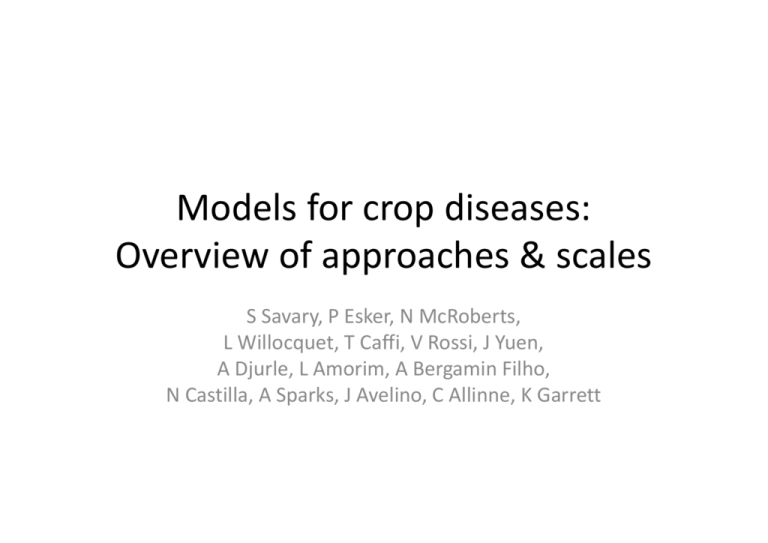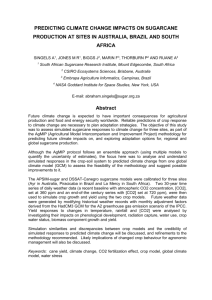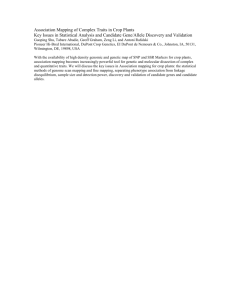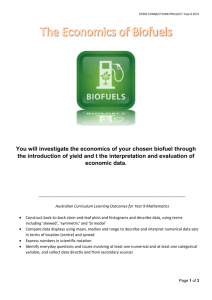Models for crop diseases: Overview of approaches & scales
advertisement

Models for crop diseases: Overview of approaches & scales S Savary, P Esker, N McRoberts, L Willocquet, T Caffi, V Rossi, J Yuen, A Djurle, L Amorim, A Bergamin Filho, N Castilla, A Sparks, J Avelino, C Allinne, K Garrett Background • Modeling plant diseases: many different approaches used, with different objectives Two main objectives in modeling plant disease: • • • • Modeling the dynamics of plant disease epidemics Modeling crop losses – the effects of plant disease (pest) on crop growth and performance With the ultimate goal of improving disease management, and so: • A very large number of pathosystem (Host + Pathogen) ‐ specific disease management models Brief overview of epidemiological simulation modelling – Types of epidemics and models (monocyclic; polycyclic; mixed monocyclic‐ polyclic) – Spatialized models (explicit, implicit spatialization) – Primary inoculum – Polyetic processes – Genetic diversity of the pathogen epidemiological modeling Epidemiological structural patterns Polycycle – Fraction Host Tissue Monocycle Fruiting Body ‐ Panicle or Head Seed‐ or soil‐borne diseases Mixed – Shoot or Tiller Vector‐borne epidemiological modeling An epidemiological example: EPIRICE 'correction' factor total diseased sites C D Rate of growth RG Rate of infection H healthy sites latent sites infectious sites L RS I RI S senesced sites basic relative infection rate Rc 'removed' sites P Vanderplank J.E., 1963. Plant Diseases. Epidemics and Control. Academic Press, New York. Zadoks J.C. 1971., Systems analysis and the dynamics of epidemics. Phytopathology 61:600-610 Savary, S., Nelson A., Willocquet L., Pangga I., Aunario J., 2012. Modelling and mapping potential epidemics of rice diseases globally. Crop Protection, In Press. epidemiological modeling spatial scales of plant disease epidemics in EPIRICE - local infections on the foliage - 1 lesion = a small fraction of leaf area - ex.: leaf blast; brown spot - rapidly expanding infections on the foliage - 1 lesion = a leaf - ex.: bacterial blight - infections affecting entire tillers - 1 lesion = a tiller - ex.: sheath blight - systemic infections - 1 lesion = a plant - ex.: tungro epidemiological modeling Avg 1997-2008 Brown spot Std 1997-2008 epidemiological modeling Avg 1997-2008 Leaf blast Std 1997-2008 epidemiological modeling Another epidemiological example: Modelling grapevine powdery mildew epidemics under different CC scenarios Model simulations of powdery mildew severity (%) in a scenario of low‐intermediate conduciveness (black symbols) and high conduciveness (grey symbols) for the disease according to scenarios A2 and B2 for Cembra (higher elevation). 10‐year moving average lines are superimposed on the series. Caffarra, A., Rinaldi, M., Eccel, E., Rossi, V., & Pertot, I. (2012). Modelling the impact of climate change on the interaction between grapevine and its pests and pathogens: European grapevine moth and powdery mildew. Agriculture, Ecosystems & Environment, 148, 89‐101. Challenges (J. Yuen, pers. comm.) time scale (epidemiological processes studied) << time scale (processes in crop models) << time scale (climate change scenarios) epidemiological modeling Brief overview of crop loss simulation modelling –Crop (agrophysiological) growth models with damage mechanisms –Damage mechanisms –RI – RUE models – multiple diseases (pests) models Yield and yield loss modeling Production levels Production levels: radiation temperature crop phenology physiological properties crop architecture Yield defining factors Potential Attainable Actual Yield limiting factors Yield reducing factors water nitrogen phosphorus pests diseases weeds pollutants calamities Rabbinge, R. 1993. The ecological background of food production. In: Crop protection and sustainable agriculture. Ciba Foundation 77. Chadwick DJ, Marsh J, Eds. John Wiley & Sons, Chichester, UK. Van Ittersum, M. K., and Rabbinge, R. 1997. Ecology for analysis and quantification of agricultural input‐output combinations. Field Crops Res. 52:197‐208. Yield and yield loss modeling Simulation modelling of yield losses ‐ examples Crop Pest Reference Rice Leaf blast Bastiaans, 1993 Rice Multiple diseases Pinnschmidt et al, 1994 Rice Multiple pests Willocquet et al, 2000; 2002; 2004 Rice, wheat Multiple pests Aggarwal et al, 2006a; 2006b Wheat Aphids Rossing, 1991 Wheat Leaf rust Roermund & Spitters, 1990 Wheat Multiple pests Willocquet et al, 2008 Potato Multiple pests Johnson, 1992 Yield and yield loss modeling Damage mechanisms of crop pest injuries Damage mechanism Physiological effect Effect in a crop growth model Examples of pests Light stealer Reduces the intercepted radiation Reduces the green LAI Pathogens producing lesions on leaves Leaf senescence accelerator Increases leaf senescence, causes defoliation Reduces leaf biomass by increasing the rate of leaf senescence Foliar pathogens such as leaf spotting pathogens, downy mildews Tissue consumer Reduces the tissue biomass Outflows from biomasses of the injured organs Defoliating insects Stand reducer Reduces the number and biomass of plants Reduces biomass of all organs Damping‐off fungi Photosynthetic Rate reducer Reduces the rate of carbon uptake Reduces the RUE Viruses, root‐infecting pests, stem infecting pests, some foliar pathogens Turgor reducer Disrupts xylem and phloem transport Reduces the RUE, accelerates leaf senescence Vascular, wilt pathogens Assimilate sapper Removes soluble assimilates from host Outflows assimilates from the pool of assimilates Sucking insects, e.g. aphids, some planthoppers, biotrophic fungi exporting assimilates from host cells … and an eighth mechanism: reproductive tissue transformation (smuts and gall midges) – A. Djurle, Pers. Comm. Rabbinge, R., and Vereyken, P. H. 1980. The effects of diseases or pests upon host. Z. Pflanzenk. Pflanzensch. 87:409‐422; Rabbinge, R., and Rijsdijk, P. H. 1981. Disease and crop physiology: a modeler’s point of view. Pages 201‐220 in: Effects of Disease on the Physiology of the Growing Plants. P. G. Ayres, ed. Cambridge Univ. Press, Cambridge, UK; Boote, K. J., Jones, J. W., Mishoe, J. W., and Berger, R. D. 1983. Coupling pests to crop growth simulators to predict yield reductions. Phytopathology 73:1581‐1587; Savary S, Willocquet L. 2014. Simulation Modeling in Botanical Epidemiology and Crop Loss analysis. APSnet Education Center. The Plant Health Instructor. DOI: 10.1094/PHI‐A‐2014‐0314‐01. Yield and yield loss modeling Incorporating different damage mechanisms into a crop growth model: GENEPEST Photosy nthetic rate reducer RAD k Turgor reducer Light Stealer RUE Rate of assimilate div ersion RG Assimilate sapper LAI PartL PartR PartS Leaf B Pool StemB StorB RTransloc RremL Leaf senescence accelerator rrsenL PartSO Savary S, Willocquet L. 2014. Simulation Modeling in Botanical RootBEpidemiology and Crop Loss analysis. APSnet Education Center. The Plant Health Instructor. DOI: 10.1094/PHI‐A‐2014‐ 0314‐01. Leaf consumer Yield and yield loss modeling Turgor reducer RICEPEST structure Savary S, Willocquet L. 2014. Simulation Modeling in Botanical Epidemiology and Crop Loss analysis. APSnet Education Center. The Plant Health Instructor. DOI: 10.1094/PHI‐A‐2014‐0314‐01. Yield and yield loss modeling Pests included in WHEATPEST • Diseases – brown rust, yellow rust, powdery mildew, Septoria tritici blotch, Stagonospora nodorum blotch – eyespot, sharp eyespot – Fusarium stem rot – Fusarium head blight – take‐all Willocquet L, Aubertot – BYDV • Insects – aphids • Weeds JN, Lebard S, Robert C, Lannou C, Savary S, 2008. Simulating multiple pest damage in varying winter wheat production situations. Field Crops Research 107: 12‐28. Yield and yield loss modeling WHEATPEST structure B YDV TBASE TM IN EYS FST WD TA K k RA D TM A X SHY RUE SLA DTEMP LAI APH RG ST SN YR BR PM RSA P RDIV STEMP Willocquet L, Aubertot JN, Lebard S, Robert C, Lannou C, Savary S, 2008. Simulating multiple pest damage in varying winter wheat production situations. Field Crops Research 107: 12‐28. DVS POOL RLEA F RSTEM CP L LEAFBM RRSENL CP ST REA R RROOT CP R CP E STEMBM ROOTBM EARBM RDIST RSENL FHB Yield and yield loss modeling Linking epidemiological and yield loss modeling: Example: combining EPIRICE and RICEPEST (Courtesy Adam Sparks, IRRI) epidemiological & yield and yield loss modeling Example: simulated yield gains from host plant resistance to rice bacterial blight (Courtesy Adam Sparks et al., IRRI) epidemiological & yield and yield loss modeling Assessment of achievements and needs Progress: damage mechanisms & models • Much progress has been made on the modeling of the effects of harmful organims on crops (damage mechanisms) • As a result, it is possible to model crop losses caused by one or multiple injuries (diseases, pests) in a generic manner (i.e., any crop, any disease/pest) Assessment of achievements and needs Progress: losses to multiple injuries • Disease management often has to account for the existence of multiple diseases and pests in order to be relevant and efficient • From a crop loss – crop performance – perspective: addressing multiple diseases (and pests) is desirable • Yield loss models (e.g., RICEPEST, WHEATPEST) incorporating multiple injuries (diseases, insects, weeds) have been developed Assessment of achievements and needs Obstacle: actual field injury data • But the availability of injury functions – the time course of diseases/pests under actual field conditions – is a major obstacle Assessment of achievements and needs Challenges • Even for the main food crops worldwide (rice, wheat, maize, soybean, potato), there is a critical shortage of field data on observed (multiple) injuries • The shortage of field data – not the limitation of process‐knowledge – is the main obstacle in modeling crop pests and diseases and their relations to crops Assessment of achievements and needs Steps forward • A critical step forward would be to develop a generic modeling framework for injury functions (ideotypes of injury time courses) • representing the dynamics of injury over time in reference, key, conditions • along with other dynamics (i.e., other disease/pest) • These collective dynamics of injury functions representing multiple injury = Crop Health scenarios • which, in turn, could be used as drivers for crop loss models Concepts for a new AgMIP Group Our emphasis within AgMiP is on generic epidemiological and generic crop loss modelling structures Concepts for a new AgMIP Group • Crop growth models: exist potential yield (T, rad, plant genotype) attainable yield (same, + yield limiting factors) • New step: add yield‐reducing factors to existing models: implies driving functions for diseases (pests) couplers = damage mechanisms • Missing: driving functions for diseases develop a framework to model potential (if necessary, multiple) epidemics Framework of activities for a proposed AgMiP Research Group • • • • Focusing on crop health (multiple diseases, pests) Generic simulation models for disease epidemics Enabling to develop crop health scenarios A crop health scenario = a set of injury levels caused by different diseases, pests • Crop health scenario: used as driver to model crop growth and crop loss • Allows addressing (1) potential and actual crop health risks and (2) crop losses and (3) yield gains (from management) in a generic manner Target patho‐ systems Wheat Temperate Crops and Ecologies Table to fill Check « ecologies » NOT too many crosses X Tropical humid Tropical dry Rice Potato Soybean Coffee X Etc. X X Tropical mountain To be discussed further: ‐ perennial crops: grapevine ‐ other or different annual crops X X X Etc.





